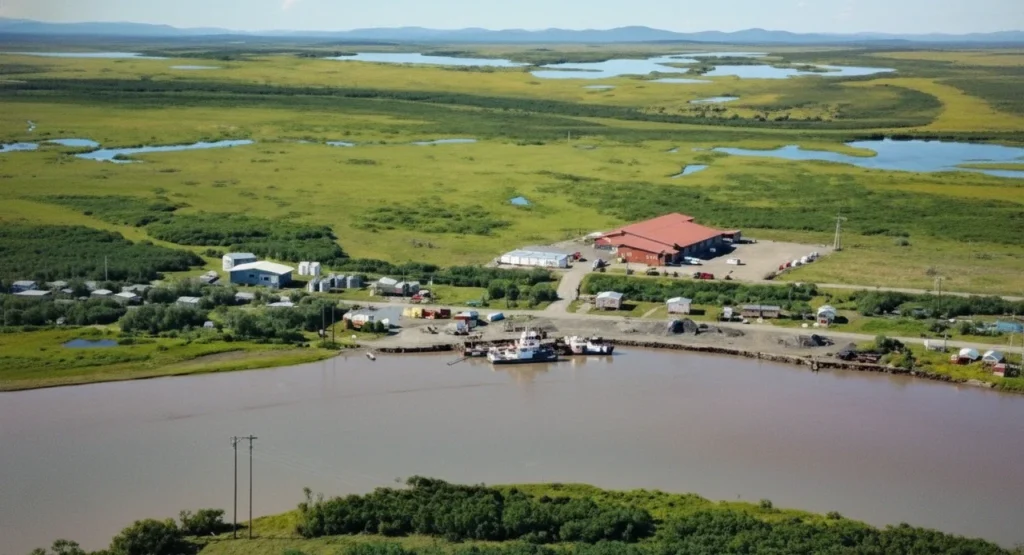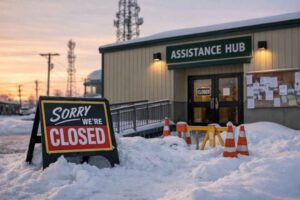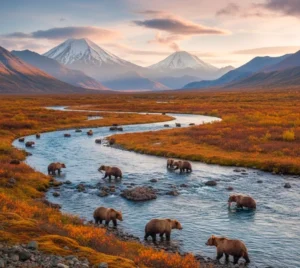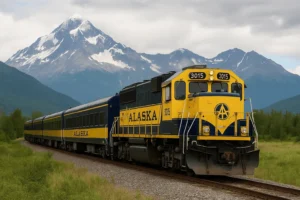Alakanuk, Alaska, is a small village in the Yukon River Delta with roughly 750 residents, most of whom are Yup’ik Alaska Natives. Despite isolation and erosion challenges, the community has found a remarkable balance between traditional subsistence living and modern comforts like piped water, broadband, and renewable energy.
Where Is Alakanuk, Alaska, Located? Geography and Climate
Alakanuk lies at the east entrance of Alakanuk Pass, the southern channel of the Yukon River Delta, just 15 miles from the Bering Sea and 8 miles southwest of Emmonak.
It’s considered the longest village on the lower Yukon, stretching nearly 3 miles along the riverbank.
| Quick Facts (2025) | Details |
| Coordinates | 62.6889° N, 164.6152° W |
| Total Area | 41 sq mi (21% water) |
| Region | Kusilvak Census Area, Western Alaska |
| Population (2025 est.) | 714 – 756 residents |
| Protected Area | Yukon Delta National Wildlife Refuge |
| Climate | Sub-arctic: winters down to −25°F; summers up to 79°F |
| Annual Snowfall | ~60 inches |
| Annual Rainfall | ~19 inches |
When the Yukon River freezes from November to May, it transforms into an ice road connecting neighboring villages.
Meaning and Early History of Alakanuk
The word Alakanuk comes from the Yup’ik language, meaning “the wrong way” or “mistake village.”
Early explorers coined the name for the river’s winding channels, but locals embraced it as a symbol of resilience.
Historical Timeline:
- Founded by a Yup’ik shaman named Anguksuar
- First recorded by the U.S. Coast & Geodetic Survey (1899)
- Post office established in 1946
- Incorporated as a second-class city in 1969
For centuries, the Yup’ik people have depended on the river for food, travel, and storytelling foundations that still guide life in Alakanuk, Alaska, today.
People and Culture: The Heart of Alakanuk, Alaska
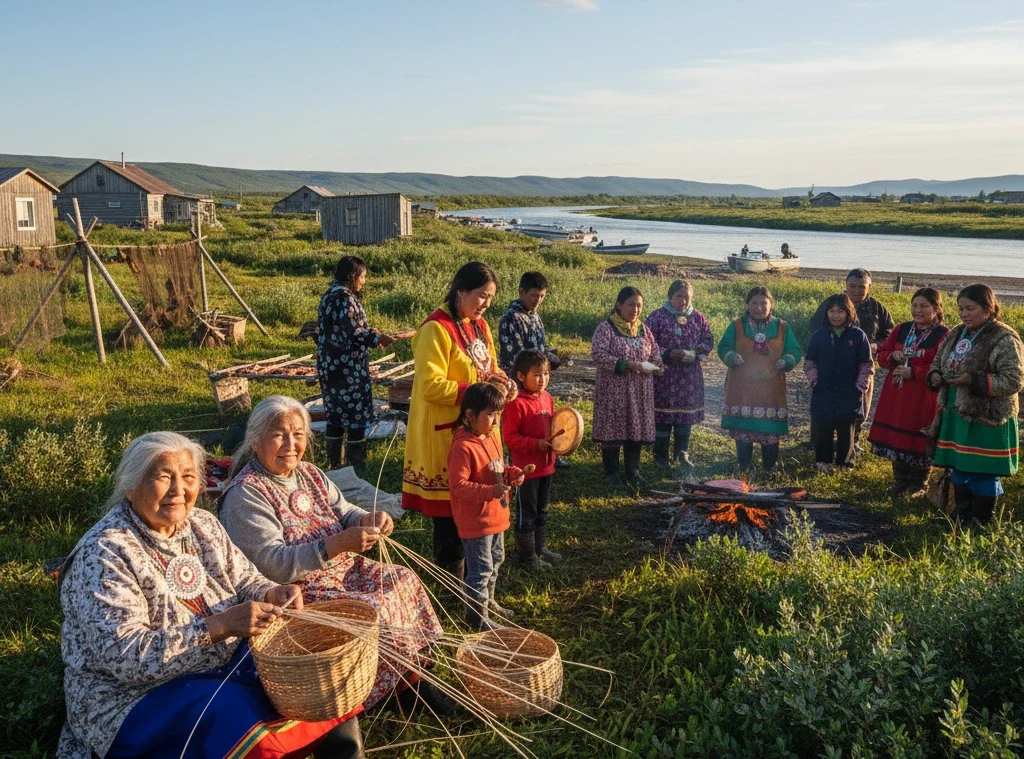
Community is the lifeblood of Alakanuk. According to the Alaska Department of Labor, the population remains youthful and deeply rooted in family structures.
| Indicator | 2025 Data |
| Population | ~750 |
| Alaska Native (Yup’ik) | 87.9% |
| Median Age | 21.5 years |
| Average Household Size | 4.5 people |
| Median Income | ≈ $39,600 |
Large, multi-generational households are common. Elders pass down oral traditions and stories in Yup’ik, while younger residents stay connected through smartphones and broadband.
A local fisherman said it best:
“We’ve been selling fish or trading it for decades. It’s not business. It’s a community.”
Subsistence Living and Yukon River Traditions
Daily life in Alakanuk still moves with the Yukon River’s rhythm.
| Key Subsistence Foods | Season/Use |
| Salmon | Main summer harvest |
| Beluga whale & seal | Coastal hunts |
| Moose & rabbit | Winter protein |
| Berries & roots | Seasonal gathering |
Fishing camps, smokehouses, and community food exchanges keep ancestral traditions alive.
Even as salmon runs fluctuate and regulations tighten, families adapt, balancing freezer goods with traditional harvests.
Modern Alakanuk, Alaska Living: Infrastructure, Water, and Power

Modern utilities have transformed comfort in Alakanuk, without erasing its cultural roots.
💧 Water and Sewer
- Around 90% of homes are now connected to piped water and vacuum sewer systems.
- A heated 300,000-gallon tank ensures continuous flow even at −40°F.
- The remaining homes use a central watering point and sewage lagoon.
⚡ Power and Energy (AVEC Alaska)
- Electricity is supplied by the Alaska Village Electric Cooperative (AVEC) using diesel generators with heat-recovery efficiency.
- Solar assist projects are underway to reduce fuel dependence and costs.
🚧 Erosion Control and Relocation
- Over 25 homes have been relocated inland to combat coastal erosion.
- New subdivisions, backed by Alaska DEC and AVCP, offer safer ground while keeping river access for fishing and travel.
Healthcare and Connectivity in Alakanuk, Alaska
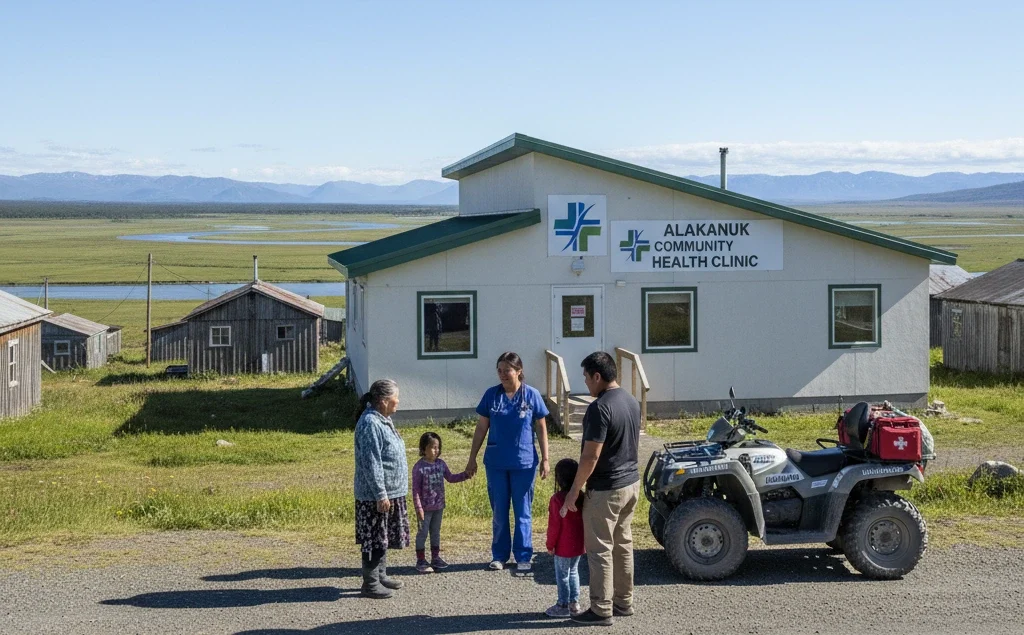
Primary healthcare is provided by the Alakanuk Health Clinic, supported by regional facilities in Emmonak and Bethel.
Emergency medical flights and telehealth consultations ensure access despite distance.
Broadband internet is improving through Western Alaska fiber expansions, though outages like the 2025 Quintillion network disruption still show how fragile connectivity can be in rural Alaska.
How Alakanuk Balances Tradition and Modern Alaska Living
What makes life in Alakanuk, Alaska, remarkable than other places like Adak is how the community blends old and new seamlessly.
| Aspect | Traditional Strength | Modern Upgrade | The Balance You See |
| Food | Subsistence harvests & sharing | Store goods & utilities | Seasonal mix |
| Housing | River access | Erosion relocation | Safer homes near the river |
| Education | Yup’ik language & culture | STEM & digital learning | Dual approach |
| Economy | Customary trade | Wage jobs & sales tax | Hybrid system |
| Health | Elders’ care & healing | Clinics & telehealth | Integrated wellness |
| Energy | Natural rhythms | AVEC diesel grid | Reliable living |
| Connectivity | Oral teaching | Broadband & social media | Heritage online |
You’ll still find fish racks beside Wi-Fi routers, snowmachines parked near classrooms, and children singing Yup’ik songs after online homework, a living blend of eras.
Education and Youth: Tradition Meets Technology
At Alakanuk School (K–12), students bridge two worlds daily.
Elders visit classrooms to teach language and storytelling, while digital tools help preserve oral history online.
Distance learning and coding labs coexist with cultural arts programs, ensuring education never loses its local identity.
Employment Sector
Roughly 70 residents are employed in education, healthcare, or retail, while others depend on commercial fishing and seasonal work.
The customary trade network bartering fish, meat, and goods remains the village’s invisible economy, strengthening community ties.
Community Life and Local Governance
Alakanuk is a dry community; alcohol sales and imports are prohibited.
The Village of Alakanuk Tribe and City Council jointly oversee:
- Utility management
- Youth leadership programs
- Cultural and mental-health initiatives
Their collaboration is recognized across Western Alaska as a model for rural resilience.
Visiting or Moving to Alakanuk, Alaska
Alakanuk is not accessible by road, but travelers can reach it via:
- Air travel: a 4,000-foot gravel runway served by regional carriers.
- Boat: during the summer months via the Yukon River.
- Winter ice road: connecting nearby villages when the river freezes.
The cost of living is higher than Alaska’s urban average due to freight costs, but subsistence practices and community sharing offset many expenses.
Challenges and Strengths of Modern Life in Alakanuk
| Challenges | Strengths |
| Erosion & relocation costs | Strong tribal governance |
| Declining salmon runs | Youth engagement & education |
| High freight & fuel costs | Reliable modern utilities |
| Internet instability | Cultural continuity & unity |
In Alakanuk, balance isn’t a metaphor; it’s survival.
The people blend tradition and innovation to stay connected to both the land and the world.
FAQs
1. What is life like in Alakanuk, Alaska?
Life centers around the Yukon River fishing, family, and tradition, combined with modern amenities like power, internet, and piped water.
2. How do Alakanuk residents get food and supplies?
Through a mix of subsistence fishing, hunting, and deliveries from regional hubs like Bethel and Emmonak.
3. Is Alakanuk affected by climate change and erosion?
Yes. The community has moved over 25 homes inland to avoid erosion from rising river and sea levels.
4. What language do people speak in Alakanuk?
Most residents speak Yup’ik and English, with active efforts to preserve the native language in schools.
5. Can visitors travel to Alakanuk by road?
No. Travel is by plane, boat, or winter ice road; there are no year-round highways.






